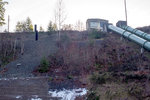
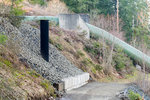
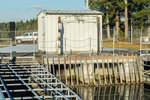
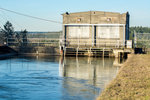
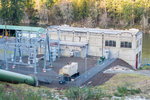
The average person could walk down the hillside to the powerhouse at the Yelm Hydroelectric Project without noticing a single rock or tree branch out of place.
That wasn’t the case six weeks ago, after a series of events triggered by a windstorm led to water cascading out of a small ventilation pipe onto the steep grade, washing out service roads and exposing more than 100 feet of spillway piping to the elements.
As much as four feet of rock was displaced from some sections, leading Centralia City Light, which operates the hydroelectric facility, to seek an emergency declaration from the city council and later a contract with an Aberdeen-based company for about $200,000 of expedited services to essentially rebuild the hillside.
Snow and ice that dominated much of Washington state for the first half of February slowed their progress, but as of Thursday afternoon, the needed repairs had been all but finished.
“It was a pretty bad washout,” said city of Centralia engineer Jan Stemkoski. “The water pushed a bunch of large ecology blocks off the roadway and down the hillside. … We still need to get debris out of the vent pipe itself, but we’ll get that done quickly with our own bucket truck.”
Workers were able to use a specialized truck with an extendable arm to remove most of the ecology blocks — large cement fixtures used to mark or block off city access roads — but left behind a couple that weren’t close to the spillway.
The sequence of events that led to the cascade of multi-ton blocks began on Jan. 6 when a windstorm caused a power outage at the facility, triggering the closure of valves sending water to the main turbines.
That water would normally be rerouted down a spillway and out to the Nisqually River, but debris from the storm jammed the spillway, forcing it out a narrow ventilation pipe and onto the hillside. M.L. Norton, City Light general manager, said in January the flooding created a cavern 50-feet across underneath the exposed pipe.
City officials worked with a third-party geo-engineering firm to create a planning document following the incident that was used to speed up the approval process for needed repairs.
“We had the engineers come up here with us and take a look at how we could scheme to put it all back together,” Stemkoski said. “We shipped it off to (the Federal Energy Regulatory Commission) which got it approved (Jan. 22). They got it through pretty quick largely due to it being an emergency.”
Stemkoski said the steep grading of the slope, as much as 70 percent in one area, added to the extent of the damage. The penstocks measuring 7 feet across that carry water down to the powerhouse, where as much as 11 megawatts of power are generated for City Light customers, were not affected by the situation.
Workers used new ecology blocks to reinforce the toe of the slope at the base of the hillside and as foundations for rebuilt access roads across to the penstocks. A truck equipped with a conveyor belt was used to spread a combination of crushed rock and controlled density fill — a self-compacting material similar to cement — to cover the exposed pipe.
Norton is expected to provide a final update on the repair efforts during a Centralia City Council meeting on Tuesday.